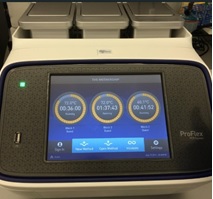Team:Oxford/protocols/NEB Q5 PCR
From 2014.igem.org
NEB Q5 PCR
↩ Back to other protocols.
(Q5 is a high fidelity DNA polymerase supplied by New England Biolabs)
- Calculate Tm and annealing temperatures of primer pairs using the NEB Tm Calculator.
NOTE: If your primers are not entirely complementary to the template, remember to calculate annealing temperatures for the first annealing reaction (primer to template) not the whole primer length.
- Dilute each lyophilized primer (from IDT) with nuclease-free water to get solutions of 100 μM.
e.g. if 80.8 nanomoles of primer, add 0.808 ml of nuclease-free water.
Make up dilution in tube primer delivered in. Pipette up and down then spin gently in bench centrifuge to thoroughly mix. NOTE: Do not contaminate water filter nozzle when collecting nuclease-free water.
- Add 45 μl of nuclease free water to a 1.5 ml Eppendorf. Add 5 μl of a primer to give a 1 in 10 dilution (10 μM). Repeat in a fresh Eppendorf for each primer. Mix thoroughly.
NOTE: Change tip before replacing pipette into nuclease-free water to prevent contamination of all following samples.
- For a 25 μl PCR reaction add the following to PCR tubes on ice and pipette up and down to mix:
- Take samples into Bayer/Berks lab to ProFlex PCR machine.
This system has a heated lid so there is no need to overlay sample with mineral oil before use.
- Touch PCR machine control screen to check if all three blocks are currently in use. If not, use touch screen to set up PCR reaction programme. Set annealing temperature and melting temperatures as calculated earlier. Set extension time dependent on length of fragment: 30 seconds per 1000bp. Place PCR tube in appropriate block and close lid. Set programme running.
NOTE: If there is a PCR tube in the block but the reaction programme has finished, remove the PCR tube and place it in the box in the top shelf of the fridge to the right of the PCR machine.
- When PCR reaction is complete remove the PCR tubes and do a DpnI Digest to remove template DNA.
 "
"

